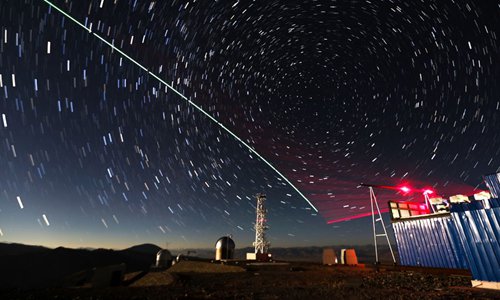Chinese university confirms feasibility of establishing space-to-ground quantum communication network

Composite photo taken on Dec. 9, 2016 shows a satellite-to-earth link established between quantum satellite "Mozi" and the quantum teleportation experiment platform in Ali, southwest China's Tibet Autonomous Region. For his role in pushing forward the development of quantum communications, Chinese physicist Pan Jianwei has been included in Nature's 10, the annual list of 10 people who mattered in science in 2017, which was released online Dec. 18, 2017 by the prestigious British journal "Nature".(Xinhua/Jin Liwang)
Scholars from a Chinese university and several research institutions published a thesis in British weekly scientific journal Nature that confirms the feasibility of establishing space-ground quantum communication work. This lays the scientific and technological foundation for achieving a quantum communication network that covers the world.
The thesis was published by scholars from the University of Science and Technology of China (USTC) in partnership with research teams from Shanghai Institute of Technical Physics under Chinese Academy of Sciences and the Jinan Institute of Quantum Technology. The thesis is entitled An integrated space-to-ground quantum communication network over 4,600 kilometres, according to an article published on the official website of USTC.
According to the article, based on the connection of China's Beijing-Shanghai quantum communication network, the world's first quantum-encrypted network, and the Mozi satellite, the Chinese research groups demonstrate the world's first integrated space-to-ground quantum communication network over 4,600 kilometers that combines a large-scale fiber network of more than 700 fiber quantum key distribution (QKD) links and two high-speed satellite-to-ground free-space QKD links.
According to the abstract of thesis, the QKD technique has the "potential to enable secure communication and information transfer," which is one of the most advanced features for quantum communication network. It also noted that the research staff have taken more than two years to conduct stability and safety tests on it, and proved that the Beijing-Shanghai quantum communication network can withstand all currently known quantum hacking methods and ensure cyber safety.
According to the announcement of USTC, the Beijing-Shanghai quantum communication network, opened in 2017, exceeds 2,000 kilometers in length, and covers 32 modes in four provinces and three cities. Four quantum MANs (metropolitan area network) in Beijing, Jinan, Hefei and Shanghai are connected by two ground satellite stations with the Mozi satellite. The network now has been applied over 150 users in finance, power and government administration.
At the beginning of 2019, the State Grid Corporation of China established a QKD channel spanning 2,600 kilometers from Beijing headquarters to State Grid Xinjiang Uygur Autonomous Region based on this network, which realized the encrypted transmission of power communication data and proved the feasibility of applying the network to real scenarios.
